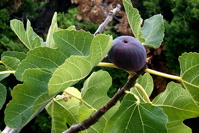Good Fences Make Good Gardens
I recently saw a great article on starting mounded raised bed gardens, but was surprised to see that one of the sample photos showed a garden only a couple of feet from the fence. Fences are an incredible garden asset, and making them part of your garden plan will really help you get the most out of your garden.
- Fences as microclimates: extend your garden season.
- Fences as a trellis: go vertical!
- Fences as barriers: support zones for beneficial plants and critters.
A fence line is a naturally productive area, since it creates its own microclimate. If it's got a sunny, southern or western exposure, you can use it as kind of a mini-greenhouse area for perennials that need a little extra boost. An old window or large sheet of clear plastic can make a nice cold-frame against any fence.
In Victorian times, estate gardeners often put an overhang with clear panes of glass along the top of a fence, to trap heat for early-blooming fruit trees. That might be overkill for most of us, but certainly a sunny fence is an excellent place to train fruit trees onto, or plant them in front of the fence. Cold breezes and strong winds are blocked by a good fence, letting your fragile plants enjoy the sun in peace.
If your fence is the northern or eastern side shady side, you have a great microclimate there, too. Lettuces, brassicas, peas, and other cool-season crops can hang on a few weeks longer there. Out of the main heat of the day, your tender seedlings can sit on a shelf on the fence, in pots, greening up and getting acclimated without being scorched and shriveled by a full day's sun. Your winter garden crop will be able to start up for fall a couple of weeks earlier, getting some critical growth in before chilling out.
A Fence is a Trellis, All Year Long
Fences are the ultimate sturdy trellis, letting you go vertical with garden crops and maximizing the productivity of your garden. You can make easy string supports by nailing into the fence, or into a board that you then fasten to the fence (easier to manage!). Some plants, like beans, and vining squashes, will just wedge their little tendrils into spaces between boards, or scamper up a wire or chain-link fence. I've had good luck stapling plastic garden netting to a fence for beans and vines, but it degrades from the sun in a year or two and now I use jute twine.
Tall crops such as tomatoes, okra, or sunflowers are often supported with stakes or cages. Another method is to attach some loops or hooks into the fence and use twine. No big cages to put away or fold up!
You can make a shady area by your sunny fence, to grow lettuce in during the hot summer. Tie twine to a small stake, pound into the ground, and angle it up to attach at the top of the fence. Run beans and cucumbers up the twine, shading the area behind them. Or use long twigs or reed stakes to lean against the fence for a similar effect. If you use tall stakes, with the string at the top, or take string out a ways from the fence, you can make a neat summer playhouse for the kids, or shady spot for a family pet.
Support Your Garden Buddies
How can you use a fence to create an ecosystem of garden helpers? Plan for a permanent 'garden helper bed' along the fence, from 12 to 24 inches wide. Put a soaker hose or drip line along it to keep it watered, and then start populating it with several of the features below:
- Mound some dirt slightly in places to create no-till areas for native ground bees, who nest in dirt or under grass tussocks. Scatter some clover seed over the mounds and water until they establish. Make sure your drip line or soaker is under, not on top of, the small, double-handful-sized mounds.
- Plant early blooming herbs and perennials to encourage your garden to get on the 'map' for pollinators. Sage, marjoram, and oregano are especially loved-- they spread, though, and you will have to cut them back a couple of times a year, or more.
- Start a flower border to attract birds who prey on insects. Sunflowers, cosmos, cornflowers, and poppies will reseed themselves annually, or you can plant a bird-and-butterfly mix. Some butterflies and moths can be garden pests, though, so be careful what you attract! Mixes designed to attract sphinx moths, for instance, will lead to the dreaded tomato hornworms in your garden.
- Create some shelters to encourage friendly and hungry toads, lizards, and salamanders who will eat slugs and bugs in your garden. Partially bury a broken flowerpot in soil, put a mound of bark nuggets on or around a big shard of flowerpot or coffeecup, stack a few rocks to leave some large cracks to duck into.
- Hang a bat house, birdhouse, or mason bee shelter on the fence. Add a birdbath or water feature.
- Make a snail attractor zone, away from your garden, so you can target them. For instance, I plant a line of yellow marigolds, which snails LOVE, and then go out at night with a flashlight to pick off the snails. That way I get them out of the garden and away from my seedlings... and out of the garden before they meet each other and start laying eggs! I also put a small dish of beer out nearby to trap slugs.
Good luck with your fences, and happy gardening!
Labels: beneficial insects, fences, integrated pest management, ipm, microclimate, mybayareagarden, trellis







